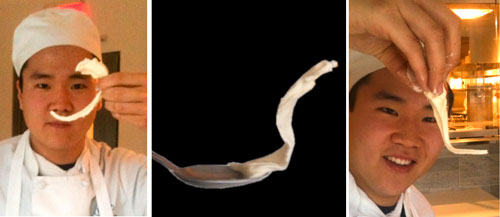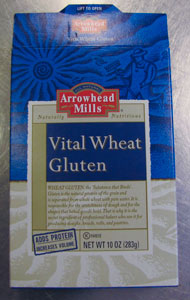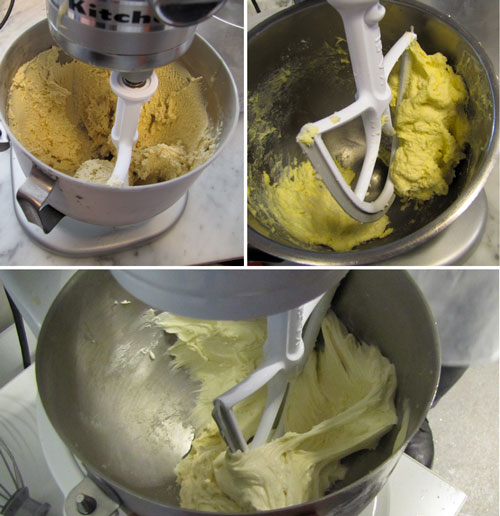by Dave Arnold
We love our stretchy potato ice cream. Read about it here.

Our interns enjoy dipping it in liquid nitrogen:

Here’s  the recipe. We use sous-vide, but you can make this ice cream base traditionally, too.
Ingredients:
250 ml milk (cold)
250 ml cream (cold)
160 grams sugar (cold, if possible)
1.5 vanilla beans, scraped
2.5 grams salt
5 egg yolks (cold)
225Â grams steamed peeled potatoes, cool
Liquid nitrogen
Preparation:
Combine milk, cream, sugar, vanilla scrapings, salt, and egg yolks in a blender. Pour into a vacuum bag and seal at the highest vacuum you can muster without spraying anglaise mix all over your vacuum machine. Cook the base in a circulated bath at 82 C for 17-20 minutes. Remove the base from the bath and smack the bag around a bit on the counter to smooth it out (we learned this technique from Joan Roca’s book, “Sous Vide Cooking”; it is a really useful step). Chill the base in an ice bath. Blend the base with the potatoes in a blender and freeze the mix with liquid nitrogen (see the liquid nitrogen primer) in a kitchen aid mixer fitted with a BeaterBlade attachment (see our other post).
People often ask us if our recipe would work with other starches or with naturally stretchy ingredients. Wylie Dufresne asked us to test the recipe with vital wheat gluten instead of potatoes.Â
Â

Â
We first tried a dose of 80 grams of wheat gluten in an anglaise base of 250ml milk, 250ml cream, 5 yolks, 100 grams sugar, and some vanilla. It wasn’t stretchy, but it did show some promise, so we upped the gluten to 150 grams. It tasted like frozen sweet bread dough ice cream. Not stretchy. Potentially useful for a cookie dough like texture, but we weren’t huge fans.
We tried the same anglaise ice cream base with 80 grams of Ultrasperse 3 instantized agglomerated starch, made by National Starch. No Stretch.

A Call for Help! Stretchy Potato Ice Cream’s Texture is Fleeting:
We recently tested our recipe with potatoes that had been cooked the day before and stored in the fridge overnight. The recipe didn’t work. WTF? Starch retro-gradation?
Johnny Iuzzini tested our recipe and said that it loses its texture as it is stored in the freezer. We haven’t noticed this problem, because we eat the stuff instantly.  Ideas, anyone?

Does the recipe work with powdered potato starch or does it need to be made with real potato?
Also, if real potatoes need to be used, i’m wondering how (or if) the 55C PME activation would change the texture or shelf life.
Howdy, We have never tried powdered potato starch.
Just a shot in the dark, but could the potatoes be picking up extra moisture in the fridge (cooked starches absorb moisture) and creating water heavy starches that make anchors for larger ice crystals to form?
Potato starch crystalizes when chilled for a while after cooking – that must change it enough for the stretchyness to go
i think ur right on the money with the starch retrogradation. a way to test that theory would be to reheat those potatoes the next day, and see if the recipe works.
the only thing i can think of right now is adding pregelatinized starch (which is cold soluble and should not crystallize-i think).that may extend the elasticity upon further freezing, theoretically.
also i wonder if this method would still work if it wasn’t for the instant freeze of the LN. ie.normal icecream making is so gradual it might also cause this issue
Dunno. I will try a normal machine after I get back to the school.
what about using potato flakes (possibly toasted?) instead of real potatoes? I am doing some really amazing gnocchi using using potato flakes (stolen by the also ingenius Ideas In Food), maybe it could work? Actually the toasted potato flakes ice cream is the flavour of my dreams… if you can make it stretchy that would be amazing!!
Sometime soon I will buy some instant mashed taters and try it.
Here are a couple of questions that might provide some clues:
1) Do you recover any stretchiness upon “reprocessing” of the ice cream? If you return the ice cream to the stand mixer, does it get it stretch back? We see this with salep-based and konjac-based ice cream.
2) If you add amylase to the mix to break down the starch, does that also diminish stretchiness?
Howdy Kent,
BTW, where is you original Salep recipe? I keep getting requests. I haven’t tried reprocessing yet, but ice cream made from day old potatoes never develops stretchiness in the first place.
I will try to test number 2 at some point.
A couple more things —
I’m sure you’re thinking about what type of potatoes will be best. You may want to compare waxy, high amylopectin potatoes with regular potatoes. There are two reasons.
One is that amylopectin is reported to be less susceptible to retrogradation. The other is that there is a difference in the extent of polymer branching between amylose and amylopectin, the two main types of starch molecules in potatoes. I am very interested in the relationship between polymer organization and stretchiness, but then what do you expect from a polymer geek?
There are waxy high amylopectin potatoes obtained by breeding. There is also “Amflora”, a genetically modified potato from BASF that contains only amylopectin. Very deft! The potato is approved for sale in Europe. Maybe you could have some smuggled in.
You might also want to try to inhibit retrogradation (which, of course, is a phenomenon related to polymer organization). A really hard freeze may prevent it. When your interns douse the ice cream in liquid nitrogen, it might retain stretchiness when returned to ambient temperature. Also, sodium nitrate supposedly inhibits the process.
Please note — I am not suggesting you inflict GM-based ice cream laced with sodium nitrate on the unsuspecting public. I’m just saying this might help with unraveling your questions. On the other hand, sodium nitrate ice cream sounds rather zesty.
Hard frozen bacon ice cream?
I wonder how similar are the mechanisms by which salep and potato ice creams built the observed structure.
Salep structure build-up is mainly due to phase separation bewteen the protein and the polysaccharide, which effectively concentrates konjac to such a degree that stretchiness is observed – note, this doesn’t happen with LBG since this gum undergoes gelation during freezing.
Coming back to the potato – It is well known that when in suspension, amylose phase separates as well so I wonder to what extent this could drive the stretchiness.
The simple, yet very telling experiments that Kent suggests, would also be my first option.
Now, it seems that the solids content of your recipe is on the high end. Have you calculated? What is the temperature at which you observe stretchiness? What would be the % of water frozen at that temperature? With all these info, you could manipulate the texture of cold and hot concoctions by defining the minimum potato/amylose (or amylopectin?) mass fraction needed for stretchiness…Food for thought.
A lot of food for thought. Looks like we will be running some more tests soon
Hey Dave.
My first reaction to this was to look into “resistant starch.” It is big in the diet fad world but in reality it is just starch that escapes your digestive system. It can be manufactured and used in the baking world for gluten-free products or to increase the fiber content of heavy flour based baked-goods. This is called RS4. There are also 3 kinds of naturally occurring resistant starches (RS1 – RS3). Because it passes through the digestive system it is considered low-calorie and low-carbohydrate.
In cooked and cooled potatoes the starches are converted and the amount of resistant starch increases from an average of 7%-13% or so. This version is RS3.
I did read also that some people believe that adding resistant starch to their baked goods increased the “tenderness of the dough.”
Anyways, it is important here to figure out what about the potatoes is making them stretchy in the first place. That will tell you why it may be degrading over time.
I would definitely try reheating some potatoes that have cooled overnight in the fridge.
Howdy Jason. We’ll be running some more tests. I wonder if we could get some people with actual analytical instruments interested in the problem.
Let me know what sort of analytical testing you are thinking on…
I might have to order some RS4 and try this at home (or work…) and see what happens.
So, I keep coming back to this whole resistant starch idea. Somehow I feel as if the gelation of the resistant starch in the potatoes. Another way to test this would be to utilize something that has a similar amount of RS3 in it, such as some legumes or some wheat RS or maybe some cereal…
Unfortunately I don’t have access to many scholarly articles or websites nor am I a food-scientist so I’m not that familiar with some of what is being talked about in a few of these articles. I’ve posted some though as they seem to relate quite a bit to what Cesar and Kent were speaking of.
If anyone has access to these articles in full (NCBI/PubMed or ScienceDirect) I would love to read them.
http://en.wikipedia.org/wiki/Resistant_starch
http://www.ncbi.nlm.nih.gov/pubmed/19562607
http://www.sciencedirect.com/science?_ob=ArticleURL&_udi=B6T6R-49NR27M-2GN&_user=10&_coverDate=12%2F31%2F1988&_rdoc=1&_fmt=high&_orig=search&_sort=d&_docanchor=&view=c&_searchStrId=1393851441&_rerunOrigin=scholar.google&_acct=C000050221&_version=1&_urlVersion=0&_userid=10&md5=617d24321d6c95460d9315bc3e669004
http://www.sciencedirect.com/science?_ob=ArticleURL&_udi=B6WHK-4CR9C3W-5&_user=10&_coverDate=12%2F31%2F1995&_rdoc=1&_fmt=high&_orig=search&_sort=d&_docanchor=&view=c&_searchStrId=1393850132&_rerunOrigin=scholar.google&_acct=C000050221&_version=1&_urlVersion=0&_userid=10&md5=fe00e067f06eef6cc5ff6a0e157dd42e
Have you tried it with RS starch yet?
Not yet. I’ve got some Resistant Corn Starch 260 on order and being shipped. It is a RS2 type resistant starch so it may not work properly. But, I’m having some issues finding RS3 type starch without making it myself (i.e. cooked and cooled potatoes…). Although it does state that RS3 is also found in legumes and breakfast cereals. I don’t know about the beans… but, it might be fun to make some breakfast cereal flour and see what happens.
It will be a few days before I have any LN2 access as well (possibly up to a week). I will definitely get back to you on my results.
Also, what about just utilizing potato starch or making a slurry of potato starch and water, heating it and then cooling it…?
Hi all, I’m requesting the papers Jason suggested – an interesting second thoughts is that it would be better then to eat your mashed potatoes the day after you make them 🙂
Jason, do you mean making your own pre-gelatinized starch?
I might have missed it from the above, but instead of using a modified or resistant starch, why not use a pregelatinized starch that is added to the cooled mix and let hydrate for 5-10 min before freezing?
Cesar – from what I’ve read it would be better for colon health and your diet to eat your mashed potatoes cold the next day. Crazy right?
Using pregelatinized starch may also be the way to go. It is worth a shot.
Let me know about those articles as well.
I just got my resistant corn starch 260 in the mail today. It was really cheap ($3/lb – $8/lb shipped – ordered only 1 lb). It is a large amount of powder.
First try with this will be based on the idea that potatoes, when cooked and cooled, increase in resistant starch to about 10%. I will use Dave’s stretchy potato ice cream recipe and based on the resistant starch being 10% I’ll use 22.5 g of Resistant Corn Starch 260.
Ok, I finally have some time at work. Tonight I’m going to make up the anglaise base and cook some potatoes. Then tomorrow night we are going to just make regular LN2 ice cream followed by stretchy with potatoes followed by a trial on the RS260 resistant corn starch as well as a trial with some cooked and cooled potato starch.
Will post results over the next week or so.
Ok, so experimentation time is over. I’d do more tonight, but it is 3:00 AM and nothing is open for me to get more ingredients to bring back to work this late.
For comparison I quadrupled the recipe Dave has listed above minus the potatoes. I also didn’t quadruple the vanilla (didn’t have that many and wasn’t buying them at the grocery store at 2 for $20…!!!). I expected because of this that I would probably taste potato.
First I made just plain ice cream with it. Yes it was a little TOO flavorful.
Next, I tried to add the potato. This didn’t quite work as well as it did for you guys at the FCI. It did appear to gain some stretchiness, but nowhere near as much as the pictures you have posted. I didn’t have an appropriate steaming vessel with me at work so I utilized a pasta pot with strainer and attempted this. The potatoes may have submerged in the water for a short period of time while I was out of the room. Could this have been the downfall here? And obviously it tasted like potato since there wasn’t enough vanilla in it.
I also tried to just utilize a large quantity of Resistant Corn Starch 260 from Netrition.com. No luck. No stretch and it tasted, well like corn starch. It also left you feeling like you had a hairy tongue, which is absolutely gross! I tried to cook this in some water (brought to simmer), but it just dissolved and once it cooled it began to separate out of the water.
Finally, I’ve been playing with potato starch a lot lately in the forums attempting with KennethT to make an edible biodegradable potato plastic (something he had at El Bulli). We are on the right track there, but it got me thinking about the cooking process of the potato starch. It becomes very gelatinous when heated with just water. The addition of an acid and glycerin makes it plastic.
So, I took 40 grams of Bob’s Red Mill potato starch and added it to 200 mL of distilled water and cooked it until just before a boil. At this point the solution thickens quickly. I then cooled this solution in a styrofoam cup. Once cooled it came out of the cup in a large jiggly mound of opaque gelatinous weirdness! I figured if I could shear it in the blender back into a liquid state then I could add the anglaise and try it. It sheared wonderfully and incorporated into the anglaise great. This was by far the closest I got to making stretchy ice cream as you did.
It didn’t have “enough” stretch though. But, the flavor profile was spot on. The potato starch gel added no additional flavors as did the steamed potato and corn starch. The final consistency was more palatable as well.
Next week or the week after (when time and money permits) I will attempt another round of trials unless you guys beat me to it. I want to double the amount of potato starch to 80 grams/200 mL water and try that and possibly move up from there.
**Click my name for new gastronomic alchemy videos!**
Nice work! I wonder if the submerging had anything to do with it. One more note: when we make the potato ice cream we steam the potatoes and then let them flash off steam as they cool. This is potentially removing a lot of moisture, which may account for the increased stretch when we make it. Have you tried using the potato starch directly in the anglaise base, potentially adding a bit more milk? I eagerly await a recipe. BTW, did the potato starch have retrogradation problems?
Hey Dave. Thanks.
In regards to submerging in the water I was curious because the potatoes didn’t have that typical “tackiness” that steamed potatoes do. They didn’t feel like boiled potatoes either, but the “tack” was definitely not as prevalent. Note here that the gel created by combining 40 grams potato starch with 200 mL water and cooking creates a gel with surface properties similar to a steamed potato. The gel was quite “tacky” on the surface.
I’m not completely sure what you mean by you let “them flash off steam as they cool…”
I wanted to try the potato starch by itself, but potato starch isn’t made by cooking a potato. Since the cooking is necessary in your recipe I thought I would try that first.
Next set of experiments will be with the potato starch uncooked blended directly into the base. My concern here is it being uncooked.
Then I will try a batch where I cook the potato starch with the base (probably add after the tempering of the eggs and cook for 10 minutes or so with the base). My concern here is that the starches may not gel properly due to over-hydration(?) or fat interference.
I’ve considered also attempting to cook the potato starch in milk (instead of water) in the first place to make a gel. Then shearing it and blending in the base. I’m curious as to the gel properties here and how the fat would interfere with the matrix.
Finally, I would like to just try another version of what I already did but double or triple the amount of potato starch (same amount of water), making thicker more viscous gels. Then shearing these into the base.
I’d be interested to try this with other starches as well. Do you know if any other starches form similar gels when cooked down like the potato starch? I could post a pic or two in the forums at the end of the week of the gels that I’m shearing.
In regards to retrogradation:
1. It is hard to tell with the potato starch ice cream. As I stated before it didn’t quite get the same stretch as you had gotten with potatoes using the potato starch. So, it is hard to tell from a stretch standpoint how much retrogradation has happened. Although, I do find that the mouth-feel of the ice cream doesn’t necessarily feel the same as it did yesterday. It almost feels as if it has become more granular. I’ll check it out again in about 8 hours to see what it is like – that will be around 24 hours post-finished product.
2. I am going to make a simple potato starch gel as I did for the initial experiment and just leave it out overnight to see what happens.
Interesting page on National Starch’s website about potato starch:
http://www.foodinnovation.com/FoodInnovation/en-US/Our+Products/Potato+Starches.htm
I’m inquiring about some free samples from them right now, especially a product called “Perfectagel MPT”.
Ok, final post for tonight.
Checked the ice cream again. I noted earlier that it seemed a little grainy and now I can almost taste the starch, albeit almost flavorless in the first place, in the product so I would say that yes retrogradation is definitely happening. It did however take much longer than what I would normally expect for a bowl of ice cream to melt. Once I try again and attain a similar stretchiness to what you were seeing then maybe I can look more into the retrogradation.